The Bagpipe Society
Lindsay System Chanter Part Two - Dreaming Pipes
I hope the article I wrote for the last edition of Chanter was of some interest. In this second instalment, I describe how the project developed beyond the initial prototypes printed at MakLab, up to the production of the “Version 2” prototype. The first prototype of the “Version 2” chanter is still my main instrument - this is the colourful red & yellow chanter that some readers may have noticed at LBPS events, or in videos on the internet. Over 40 of these chanters have since been built and sent around the world, all in sober black or brown, with ivory-coloured trim. I excuse myself for continuing to play the rainbow pipes, since each time I make a black or brown chanter someone asks me for it.
From MakLab to Shapeways
Following the development of the first playable prototype, in day-glo PLA on an Ultimaker Original at MakLab in The Lighthouse in Glasgow, work continued there for several months. Prototypes were produced in a range of keys, including a miniature high G chanter with 1mm thick walls, designed to print as quickly as possible.
3D printing, by its nature, is currently extremely slow. The “FFF” (Fused Filament Fabrication) printers currently used at home are the 3D equivalent of the “dot matrix” document printers of the 1980s & 90s. They print objects one layer at a time, using a print head fitted with a tiny brass nozzle of 0.4mm diameter, that extrudes a hair-thin bead of plastic with which the printer “draws” the object it is creating. Each layer can be anything from 0.06mm upwards, and a chanter can take anything from 5 to 10 hours or more to print. Don’t even ask about drone stocks - we have a long way to go before we reach the stage of the “Replicator” depicted in Star Trek.
As the weeks at MakLab went by, and I settled in to life in Glasgow again, work began to pick up (I am an independent electrician). Simultaneously, MakLab began to get a little bit busier. The lab was almost new when I discovered it, and many days I was the only person interested in using the Ultimaker. This began to change, and coupled with work pressures, I began to find that I didn’t have the time to supervise the prints I wanted to make. For this reason, I decided to experiment with Shapeways, which is an online service based apparently in the Netherlands (also the home of the Ultimaker). Of the materials on offer, “Strong & Flexible” is the cheapest by a reasonable margin, so I began to experiment with prints in this material.
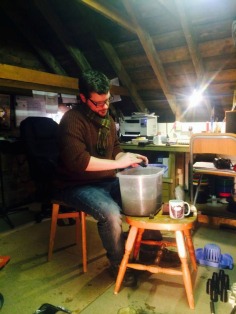
Shapeways allowed me to draw when I had time, late at night usually, and upload the file for printing. The finished print would be posted a couple of weeks later, and could then be play tested, refined and printed again. This proved fruitful, and led to the production of a working chanter in D, with a range down to G, and another following that in low G, with a range right down to low C.
The fortnight’s wait, and overall turnaround of a month or more, did make progress slower than I’d have liked at this stage. However the results were very encouraging, and the G prototype in particular proved very playable and enjoyable. There’s still a video on YouTube which demonstrates it very well:
The tuning, particularly of the high notes, isn’t perfect but bear in mind that this was the first one made at that low pitch. Most of my work at MakLab had focused on pitches of D or above, due to the 200mm vertical limit of the Ultimaker (something I later learned to overcome).
Kickstarter
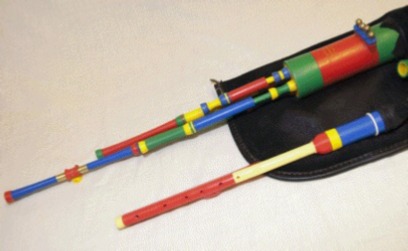
It was at this time (March 2014, as per the date on the video) that I discovered the Kickstarter crowdfunding platform. With a properly playable prototype in hand, and an urge to move the project forward faster, I jumped at the opportunity that Kickstarter presented. The crowdfunding format enables backers to pledge a small (or sometimes a large) sum of money towards a project proposal that interests them. In return, the project’s originator may offer the backer a reward of some sort - often this reward is something arising from the work undertaken during the project. In my case, the main reward offered to backers was a chanter, or in fact two. I asked for 20 backers to become “Beta Testers” for the chanter, and offered them an initial test chanter at the outset of the project, and a second finished chanter at the end of it. Those finished chanters are now in the process of being delivered!
To widen the appeal of the project, I also offered some printable 3D file sets that I had been experimenting with. These included a penny whistle (subsequently named “Qwistle”, a version of an arcane Scots spelling of “whistle”), a pocket practice chanter, a set of Highland drones, and a full set of 18th C-esque “D” smallpipes.
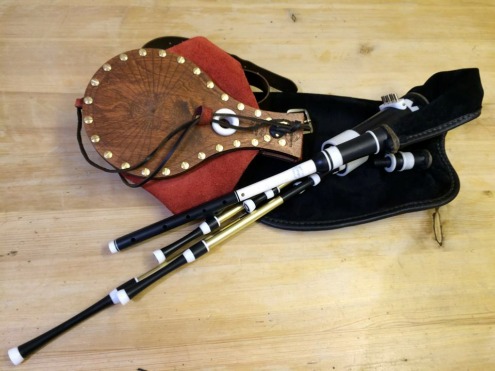
The project raised funds on Kickstarter for one month, closing on the 30th of April 2014, and raising £5,500 - enough for two printers and a good supply of printer filament. Around the time that the project closed, and in the months following, my life took on several interesting extra dimensions - some of these are private, however I’m happy to share that by September of 2014 (a notable month in many ways), my wife & I were able to welcome Rory into the world. Timing is everything of course, and these very happy events had the effect of somewhat extending the timescales of what essentially was an unpaid project - the budget had only been intended to cover printers & print costs, including no allowance for time for activities that I still at that point considered to be an interesting hobby, with the ultimate aim only of providing a more developed version of the chanter for myself and others to play. Thankfully, Dreaming Pipes’ very kind and supportive backers proved understanding, and the initial test chanters were posted around the world during December of 2015. I substituted the Version 1 chanter into my own A Smallpipe set, and have never returned to a nine note smallpipe chanter since then.
This really marked the beginning of the chanter as an instrument. With 20 pipers now in possession of one, I turned my own attention (or spare attention, once baby had finished with me) from drawing, testing, recording, reading and researching, to playing again. The chanter had successfully arrived at a range from D below low A, to High B above High A, while preserving the fingering of the range G to A as intended. The low D and E in particular had a surprisingly strong & rich tone, improved further by Version 2, while High B proved easy to use. The range above High B proved very difficult, and poorly tuned, issues later corrected to some extent. The semitones were awkward, requiring a re-think before the redrawing process began in the late summer of 2015.
For tunes, I turned mainly at this point to Scots fiddle collections, and Irish music books & recordings, and recorded upwards of 40 old school reels & strathspeys, plus jigs and classic session tunes, to share with Beta testers via SoundCloud. This discipline provided a good opportunity to lay the groundwork of technique within the new low & high range, and to begin to stretch and test the limits of the chanter to see where it might need to be improved. I didn’t make a habit of playing the chanter in public at this point (having learned from a fairly disastrous public experiment at the LBPS annual competition 2014), however when asked to contribute some smallpipes & whistle to Kirsty Potts’ fantastic album “The Seeds of Life”, I brought the test chanter & some experimental Qwistles with me and was able to use them to good effect. Track 4, “The Cuckoo’s Nest”, is the first commercially released recording to feature the chanter. Kirsty was intrigued by it, and asked for a full-on solo from it at the start of the track where the capabilities of the Version 1 test chanter remain recorded for posterity!
Kirsty’s recording wasn’t scheduled for release until November of 2015, by which time the record it provided of the chanter had become historical. The Version 2 chanter drawing & prototyping sessions began during the summer of 2015, and the final push came during the October week holiday of that year. The moment of breakthrough is virtually recorded, with two videos still online on Facebook (like or follow “Lindstruments” to view these) of original tunes that were written (or more correctly, improvised), recorded almost immediately using the final prototype of that series - which has been my only smallpipe for all purposed, professional or otherwise, since that day.
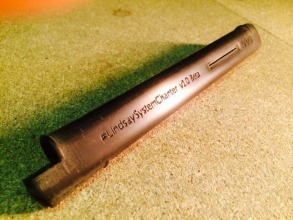
By this point, the expressions of interest in the chanter from pipers had become sufficiently frequent for me to consider offering them for sale. Although I had not initially intended to become a pipe maker (and nor had I seriously considered that I could), I decided to do so, and established the “Lindstruments” website, hoping that eventually this might provide a way to direct more of my time and energy towards refining the design. It hasn’t worked out quite like that so far, however it’s been an interesting journey, and pipers around the world continue steadily to take up the chanter. Some have even provided video & audio evidence of their, quite encouraging, efforts.
At this point, I’m going to pause the tape again, as I’m aware that Jane has a lot to fit into Chanter & is happy to let this particular shaggy dog tale run to a third article.
The third, possibly final (although probably not come to think of it) instalment will recount my experiences in beginning to emerge back into the real world with the chanter, including at sessions in Glasgow’s Glad Cafe, with step dance group The Kelvingrove Dancers, while founding the emerging bellows pipe orchestra “The Glasgow Smallpipers”, teaching the smallpipes class at The College of Piping, and in concert and the studio with musicians as diverse as Alasdair Roberts, Shane Connolly, Richard Youngs, Paul Baran, Konrad Wiszniewski, Roo Geddes, and others. If there’s time, I’ll also describe “The Brittle Light of Stars”, which is a project to develop an optical-electro-acoustic smallpipe & a music to go with it, now being taken forward in collaboration with experimental musician Paul Baran. This is already starting to sound like a fourth instalment…
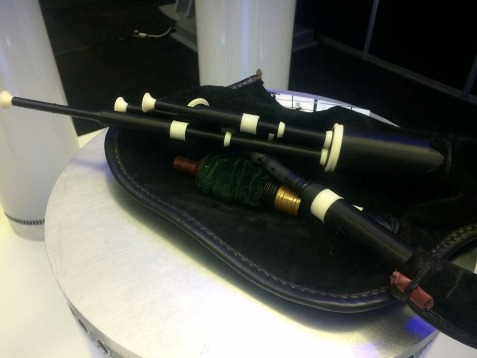
- Data Processing Notice (GDPR)
-
@BagpipeSociety on X (formally known as Twitter)
-
TheBagpipeSociety on Instagram
-
 BagpipeSociety on Facebook
BagpipeSociety on Facebook
Something wrong or missing from this page? Let us know!
